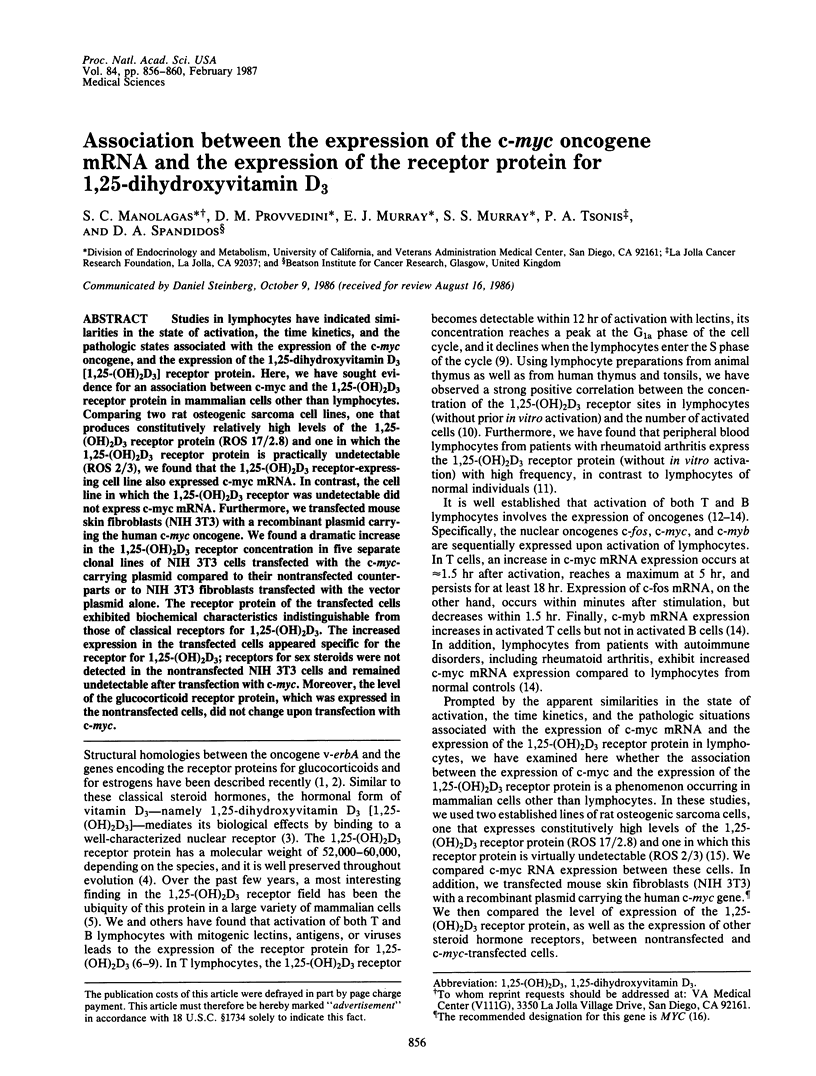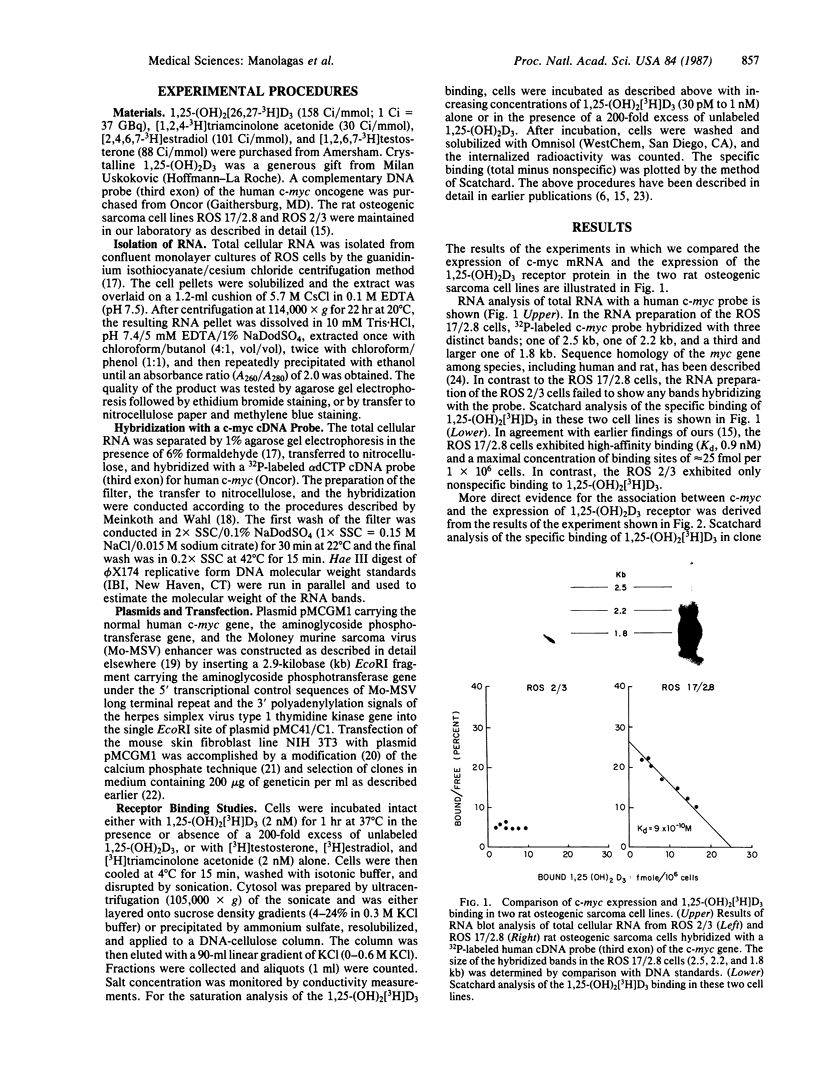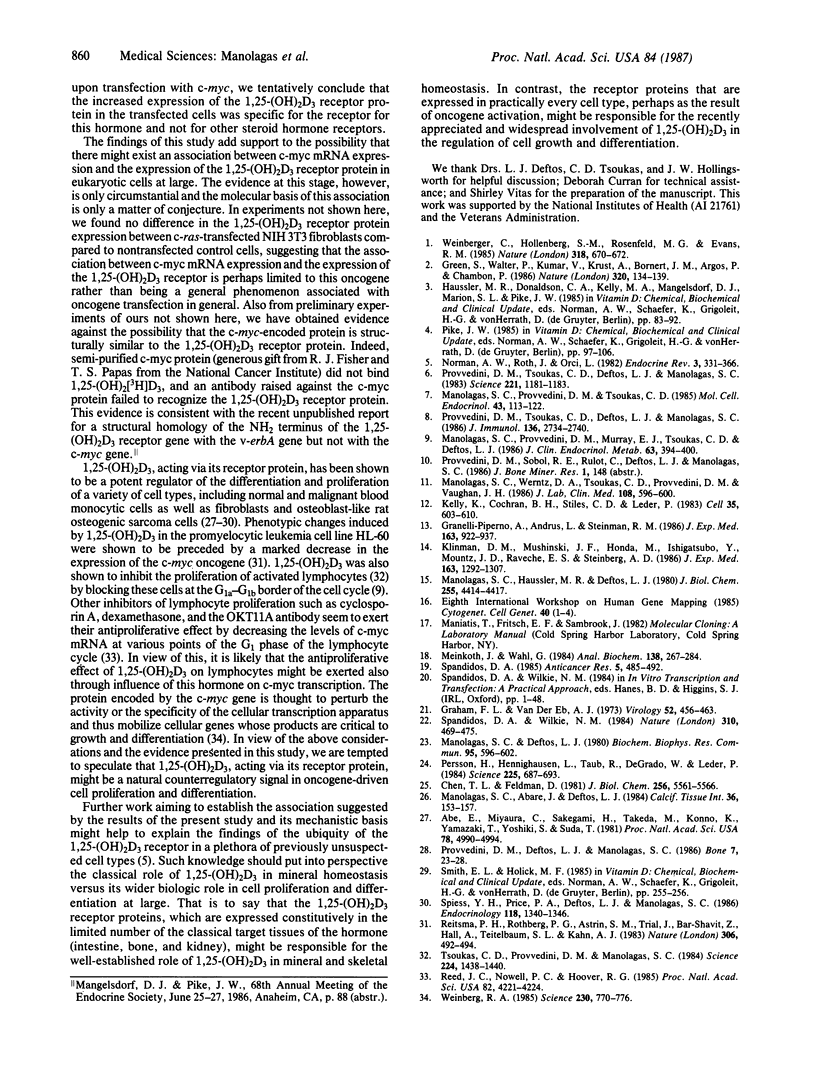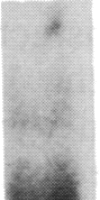Abstract
Studies in lymphocytes have indicated similarities in the state of activation, the time kinetics, and the pathologic states associated with the expression of the c-myc oncogene, and the expression of the 1,25-dihydroxyvitamin D3 [1,25-(OH)2D3] receptor protein. Here, we have sought evidence for an association between c-myc and the 1,25-(OH)2D3 receptor protein in mammalian cells other than lymphocytes. Comparing two rat osteogenic sarcoma cell lines, one that produces constitutively relatively high levels of the 1,25-(OH)2D3 receptor protein (ROS 17/2.8) and one in which the 1,25-(OH)2D3 receptor protein is practically undetectable (ROS 2/3), we found that the 1,25-(OH)2D3 receptor-expressing cell line also expressed c-myc mRNA. In contrast, the cell line in which the 1,25-(OH)2D3 receptor was undetectable did not express c-myc mRNA. Furthermore, we transfected mouse skin fibroblasts (NIH 3T3) with a recombinant plasmid carrying the human c-myc oncogene. We found a dramatic increase in the 1,25-(OH)2D3 receptor concentration in five separate clonal lines of NIH 3T3 cells transfected with the c-myc-carrying plasmid compared to their nontransfected counterparts or to NIH 3T3 fibroblasts transfected with the vector plasmid alone. The receptor protein of the transfected cells exhibited biochemical characteristics indistinguishable from those of classical receptors for 1,25-(OH)2D3. The increased expression in the transfected cells appeared specific for the receptor for 1,25-(OH)2D3; receptors for sex steroids were not detected in the nontransfected NIH 3T3 cells and remained undetectable after transfection with c-myc. Moreover, the level of the glucocorticoid receptor protein, which was expressed in the nontransfected cells, did not change upon transfection with c-myc.
Full text
PDF




Images in this article
Selected References
These references are in PubMed. This may not be the complete list of references from this article.
- Abe E., Miyaura C., Sakagami H., Takeda M., Konno K., Yamazaki T., Yoshiki S., Suda T. Differentiation of mouse myeloid leukemia cells induced by 1 alpha,25-dihydroxyvitamin D3. Proc Natl Acad Sci U S A. 1981 Aug;78(8):4990–4994. doi: 10.1073/pnas.78.8.4990. [DOI] [PMC free article] [PubMed] [Google Scholar]
- Chen T. L., Feldman D. Regulation of 1,25-dihydroxyvitamin D3 receptors in cultured mouse bone cells. Correlation of receptor concentration with the rate of cell division. J Biol Chem. 1981 Jun 10;256(11):5561–5566. [PubMed] [Google Scholar]
- Graham F. L., van der Eb A. J. A new technique for the assay of infectivity of human adenovirus 5 DNA. Virology. 1973 Apr;52(2):456–467. doi: 10.1016/0042-6822(73)90341-3. [DOI] [PubMed] [Google Scholar]
- Granelli-Piperno A., Andrus L., Steinman R. M. Lymphokine and nonlymphokine mRNA levels in stimulated human T cells. Kinetics, mitogen requirements, and effects of cyclosporin A. J Exp Med. 1986 Apr 1;163(4):922–937. doi: 10.1084/jem.163.4.922. [DOI] [PMC free article] [PubMed] [Google Scholar]
- Green S., Walter P., Kumar V., Krust A., Bornert J. M., Argos P., Chambon P. Human oestrogen receptor cDNA: sequence, expression and homology to v-erb-A. Nature. 1986 Mar 13;320(6058):134–139. doi: 10.1038/320134a0. [DOI] [PubMed] [Google Scholar]
- Kelly K., Cochran B. H., Stiles C. D., Leder P. Cell-specific regulation of the c-myc gene by lymphocyte mitogens and platelet-derived growth factor. Cell. 1983 Dec;35(3 Pt 2):603–610. doi: 10.1016/0092-8674(83)90092-2. [DOI] [PubMed] [Google Scholar]
- Klinman D. M., Mushinski J. F., Honda M., Ishigatsubo Y., Mountz J. D., Raveche E. S., Steinberg A. D. Oncogene expression in autoimmune and normal peripheral blood mononuclear cells. J Exp Med. 1986 May 1;163(5):1292–1307. doi: 10.1084/jem.163.5.1292. [DOI] [PMC free article] [PubMed] [Google Scholar]
- Manolagas S. C., Abare J., Deftos L. J. Glucocorticoids increase the 1,25(OH)2D3 receptor concentration in rat osteogenic sarcoma cells. Calcif Tissue Int. 1984 Mar;36(2):153–157. doi: 10.1007/BF02405311. [DOI] [PubMed] [Google Scholar]
- Manolagas S. C., Deftos L. J. Studies of the internalization of vitamin D3 metabolites by cultured osteogenic sarcoma cells and their application to a non-chromatographic cytoreceptor assay for 1,25-dihydroxyvitamin D3. Biochem Biophys Res Commun. 1980 Jul 31;95(2):596–602. doi: 10.1016/0006-291x(80)90826-8. [DOI] [PubMed] [Google Scholar]
- Manolagas S. C., Haussler M. R., Deftos L. J. 1,25-Dihydroxyvitamin D3 receptor-like macromolecule in rat osteogenic sarcoma cell lines. J Biol Chem. 1980 May 25;255(10):4414–4417. [PubMed] [Google Scholar]
- Manolagas S. C., Provvedini D. M., Murray E. J., Tsoukas C. D., Deftos L. J. The antiproliferative effect of calcitriol on human peripheral blood mononuclear cells. J Clin Endocrinol Metab. 1986 Aug;63(2):394–400. doi: 10.1210/jcem-63-2-394. [DOI] [PubMed] [Google Scholar]
- Manolagas S. C., Provvedini D. M., Tsoukas C. D. Interactions of 1,25-dihydroxyvitamin D3 and the immune system. Mol Cell Endocrinol. 1985 Dec;43(2-3):113–122. doi: 10.1016/0303-7207(85)90074-7. [DOI] [PubMed] [Google Scholar]
- Manolagas S. C., Werntz D. A., Tsoukas C. D., Provvedini D. M., Vaughan J. H. 1,25-Dihydroxyvitamin D3 receptors in lymphocytes from patients with rheumatoid arthritis. J Lab Clin Med. 1986 Dec;108(6):596–600. [PubMed] [Google Scholar]
- Meinkoth J., Wahl G. Hybridization of nucleic acids immobilized on solid supports. Anal Biochem. 1984 May 1;138(2):267–284. doi: 10.1016/0003-2697(84)90808-x. [DOI] [PubMed] [Google Scholar]
- Norman A. W., Roth J., Orci L. The vitamin D endocrine system: steroid metabolism, hormone receptors, and biological response (calcium binding proteins). Endocr Rev. 1982 Fall;3(4):331–366. doi: 10.1210/edrv-3-4-331. [DOI] [PubMed] [Google Scholar]
- Persson H., Hennighausen L., Taub R., DeGrado W., Leder P. Antibodies to human c-myc oncogene product: evidence of an evolutionarily conserved protein induced during cell proliferation. Science. 1984 Aug 17;225(4663):687–693. doi: 10.1126/science.6431612. [DOI] [PubMed] [Google Scholar]
- Provvedini D. M., Deftos L. J., Manolagas S. C. 1,25-Dihydroxyvitamin D3 promotes in vitro morphologic and enzymatic changes in normal human monocytes consistent with their differentiation into macrophages. Bone. 1986;7(1):23–28. doi: 10.1016/8756-3282(86)90148-1. [DOI] [PubMed] [Google Scholar]
- Provvedini D. M., Tsoukas C. D., Deftos L. J., Manolagas S. C. 1 alpha,25-Dihydroxyvitamin D3-binding macromolecules in human B lymphocytes: effects on immunoglobulin production. J Immunol. 1986 Apr 15;136(8):2734–2740. [PubMed] [Google Scholar]
- Provvedini D. M., Tsoukas C. D., Deftos L. J., Manolagas S. C. 1,25-dihydroxyvitamin D3 receptors in human leukocytes. Science. 1983 Sep 16;221(4616):1181–1183. doi: 10.1126/science.6310748. [DOI] [PubMed] [Google Scholar]
- Reed J. C., Nowell P. C., Hoover R. G. Regulation of c-myc mRNA levels in normal human lymphocytes by modulators of cell proliferation. Proc Natl Acad Sci U S A. 1985 Jun;82(12):4221–4224. doi: 10.1073/pnas.82.12.4221. [DOI] [PMC free article] [PubMed] [Google Scholar]
- Reitsma P. H., Rothberg P. G., Astrin S. M., Trial J., Bar-Shavit Z., Hall A., Teitelbaum S. L., Kahn A. J. Regulation of myc gene expression in HL-60 leukaemia cells by a vitamin D metabolite. Nature. 1983 Dec 1;306(5942):492–494. doi: 10.1038/306492a0. [DOI] [PubMed] [Google Scholar]
- Spandidos D. A. Mechanism of carcinogenesis: the role of oncogenes, transcriptional enhancers and growth factors. Anticancer Res. 1985 Sep-Oct;5(5):485–498. [PubMed] [Google Scholar]
- Spandidos D. A., Wilkie N. M. Malignant transformation of early passage rodent cells by a single mutated human oncogene. Nature. 1984 Aug 9;310(5977):469–475. doi: 10.1038/310469a0. [DOI] [PubMed] [Google Scholar]
- Spiess Y. H., Price P. A., Deftos J. L., Manolagas S. C. Phenotype-associated changes in the effects of 1,25-dihydroxyvitamin D3 on alkaline phosphatase and bone GLA-protein of rat osteoblastic cells. Endocrinology. 1986 Apr;118(4):1340–1346. doi: 10.1210/endo-118-4-1340. [DOI] [PubMed] [Google Scholar]
- Tsoukas C. D., Provvedini D. M., Manolagas S. C. 1,25-dihydroxyvitamin D3: a novel immunoregulatory hormone. Science. 1984 Jun 29;224(4656):1438–1440. doi: 10.1126/science.6427926. [DOI] [PubMed] [Google Scholar]
- Weinberg R. A. The action of oncogenes in the cytoplasm and nucleus. Science. 1985 Nov 15;230(4727):770–776. doi: 10.1126/science.2997917. [DOI] [PubMed] [Google Scholar]
- Weinberger C., Hollenberg S. M., Rosenfeld M. G., Evans R. M. Domain structure of human glucocorticoid receptor and its relationship to the v-erb-A oncogene product. Nature. 1985 Dec 19;318(6047):670–672. doi: 10.1038/318670a0. [DOI] [PubMed] [Google Scholar]




